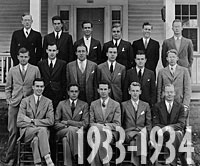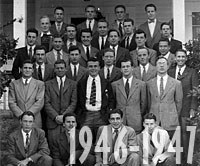|
hISTORY
On November 20, 1854, the Xi Chapter of the Fraternity of Delta Psi was founded at the University of North Carolina in Chapel Hill. Hugh Walker Gardner, the founder, matriculated at Carolina in the fall of that year, having transferred from Randolph-Macon College, where he was a charter member of the Sigma Chapter. Gardner, who was instrumental in the founding of three chapters, has been called "the greatest Delta Psi that ever lived."
Contact with other chapters was frequent. During this period the men of Xi were in constant touch with the men of Sigma Chapter (Randolph-Macon College) and Psi Chapter (Cumberland University). There were many transfers among the men of these chapters. Upon the outbreak of the Civil War, two-thirds of the ninety Xi men entered the Southern armies and fought under the Confederate flag. Sixteen Xi brothers were killed during the conflict.
Having ceased functioning in 1861, Xi Chapter became extinct in 1867. At the end of the Civil War only one member of Xi was left; the Chapter, after an existence of only thirteen years, was extinct and no immediate attempt was made to refound it.
After the reopening of the University of North Carolina at Chapel Hill in 1875, Brother George Thomas attempted to refound Xi. He arrived in Chapel Hill with one Dr. King, and pledged six men to the fraternity. Brother Thomas was no doubt unhappy to discover subsequently that the trustees of the University had banned secret organizations; he released the men from their pledges and presumably turned sorrowfully homeward. No further attempts were made in the nineteeth century to refound Xi.
In 1921, Brother Grahame Wood of the Delta Chapter recommended to the Fraternity that it investigate the possibility of refounding the Xi Chapter. Various committees visited the University of North Carolina over the next three years, culminating in a favorable recommendation to refound the chapter. The Fraternity contributed a total of $10,000 towards the tuition and lodging at Carolina for three brothers from different active chapters, who formed the "Xi Club" and began to assess interest in the Hall among other undergraduates at UNC.
After 5 years, sufficient ability to recruit new members was demonstrated, and on the 8th of October, 1926, the "Xi Club" applied for a charter from the National organization. A large committee of twenty-two brothers representing every chapter visited Chapel Hill on the 16th of October, 1926, to ascertain whether or not the "Xi Club" was worthy of a charter. The committee signed the recommendation for chapterhood while on the train returning home. The new chapter set out enthusiastically to attain the high esteem the old chapter had held. In February, 1927, the Xi Chapter moved from its rather cramped quarters at the corner of Vance and Ransom streets to a new house on the corner of West Cameron and Pittsboro streets. Yackety Yack 1928 - Fraternity Superlatives, St. Anthony Hall entry
After 1938, increasing world tension wrought its effect on the University and hence on fraternity life. 1939 and 1940 were characterized by an almost frantic gaiety in the face of the impending war; and on December 7th, 1941, the ax fell.
The end of the war returned the campus in a short time to pre-war normality, with few exceptions.
The Carolina Inn expressed an interest in the property occupied by the Hall at the corner of West Cameron and Pittsboro, and arranged a deal to provide for the purchase of another lot across the street. The Carolina Inn then converted the old Hall property into a parking lot.
The Hall moved across the street to 207 Pittsboro Street in 1960-1961.
The 1970s saw the beginning of a movement to incorporate women into the fraternity as full members. In 1971, Brother John Youngken sent out a rush letter requesting like-minded individuals to join the Hall, and later that year the first women were initiated at Xi.
|
|||||||||||
St Anthony Association of North Carolina - 4711 Hope Valley Road - Suite 4F-714 Durham, NC 27707
 Xi prospered from the beginning until in 1858 it was the third largest
chapter in the Fraternity, having at that time twenty-one men. Although
the sudden manner in which the Chapter was dissolved resulted in the
loss of many of its records, obscuring much of the early history, record
of some of the more outstanding events has nevertheless been retained.
Xi men were noted especially for their scholarship - several of the
brothers being retained after graduation to serve as tutors.
Xi prospered from the beginning until in 1858 it was the third largest
chapter in the Fraternity, having at that time twenty-one men. Although
the sudden manner in which the Chapter was dissolved resulted in the
loss of many of its records, obscuring much of the early history, record
of some of the more outstanding events has nevertheless been retained.
Xi men were noted especially for their scholarship - several of the
brothers being retained after graduation to serve as tutors.  The history of the next few years consists mainly of small events of little interest save to those concerned. This period might as well be called "The Drab Decade" - the period extending from the refounding in 1926 to the mid-1930s. Progress was made, though by no means speedily; the betterment of the Chapter appears to have been made sporadically, and to have been punctuated by several "slumps". Scholarship ran the gamut from a high degree of mediocrity to a point slightly higher. On the whole, however, the Chapter made increasingly rapid progress.
The history of the next few years consists mainly of small events of little interest save to those concerned. This period might as well be called "The Drab Decade" - the period extending from the refounding in 1926 to the mid-1930s. Progress was made, though by no means speedily; the betterment of the Chapter appears to have been made sporadically, and to have been punctuated by several "slumps". Scholarship ran the gamut from a high degree of mediocrity to a point slightly higher. On the whole, however, the Chapter made increasingly rapid progress.  The coming of World War II was accompanied and followed by an evacuation from the campus of nearly all civilian students. In their place were enrollees in the "Carolina Pre-Flight School". Almost all fraternity and sorority houses were adopted and adapted by the US Government: the collegiates moved out and were superceded by the Pre-Flight members; and once casual fraternity houses were run like barracks. St. Anthony Hall, however, was less affected as remaining members decamped to the Annex behind the main house. The Hall was expropriated to serve as Marine headquarters. This arrangement lasted for the duration of the war.
The coming of World War II was accompanied and followed by an evacuation from the campus of nearly all civilian students. In their place were enrollees in the "Carolina Pre-Flight School". Almost all fraternity and sorority houses were adopted and adapted by the US Government: the collegiates moved out and were superceded by the Pre-Flight members; and once casual fraternity houses were run like barracks. St. Anthony Hall, however, was less affected as remaining members decamped to the Annex behind the main house. The Hall was expropriated to serve as Marine headquarters. This arrangement lasted for the duration of the war.